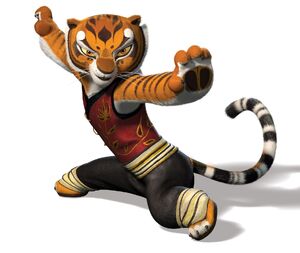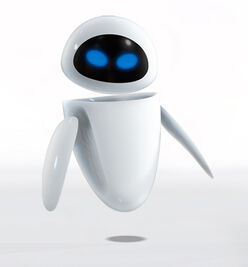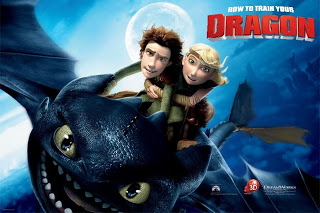There is plenty to enjoy about How to Train your Dragon. The animation is lovely, the story is energetic, and the landscape feels fresh and inviting. The film also contains a number of plot elements that are far too common in children’s films these days.
 |
| How to Train Your Dragon (2010) |
Written by Jason Feldstein
How to Train Your Dragon (Dean DeBlois and Chris Sanders, 2010) is based on a collection of books written by Cressida Cowell. The story takes place in a small village known as Berk where Vikings have been at war with dragons for three hundred years. The hero is a wisecracking passive-aggressive young boy named Hiccup. He wants to fight dragons to impress his community but he lacks the heart for it. After managing to take down a dragon known as a Night Fury, Hiccup discovers later on that he is unable to kill it. Instead he befriends the dragon, which he names Toothless, and discovers that dragons are not the creatures Vikings have always thought them to be. Toothless is one of the most enjoyable parts of the film. He looks like a cross between a bat, a panther, and a whale and his combat tactics seem to mimic those of a stealth bomber. He may be a destructive dragon, but he is also cute, loyal, and playful. Hiccup attempts to bring peace between humans and dragons but his father (and Viking leader) Stoick the Vast, sees war as the only option.
There is plenty to enjoy about How to Train your Dragon. The animation is lovely, the story is energetic, and the landscape feels fresh and inviting. The film also contains a number of plot elements that are far too common in children’s films these days. Take Hiccup for example. He is the runt of the litter who starts off as the town joke but will eventually save the day because he possesses skills that no one else does. Although he is initially looked down upon by everyone, he will end the film gaining the respect of his father and the affection of the girl he likes. It is almost a given that the protagonists in films like this have father issues. Hiccup wants to learn about dragons while his father views dragon killing as not only a necessity, but also a way of life. Stoick the Vast is a rather tiresome example of a closed-minded alpha male. He is so aggressive, hardheaded, and clueless that it’s tough to take him seriously. This is especially true when he eventually sees the error in his ways. It doesn’t help that his dialogue is so poorly written. I felt no regret when he told Hiccup in a clichéd fashion that he is no longer his son.
The film doesn’t make much use of its female characters. Hiccup’s mother is dead like many mothers in animated films geared towards children. Her only purpose is to provide the male protagonist with some sort of emotional complexity. There is a female elder who picks which student slays a ceremonial dragon but she is only in the film for a few seconds and she has no dialogue. The most prominent female character is a young Viking hotshot named Astrid. She is the star pupil in dragon training who is tough as nails and always on edge. If this character seems familiar it’s because she is. She’s Colette from Ratatouille, Eve from Wall-E, and Tigress from Kung Fu Panda. She is the latest in a long string of female characters that are tough and talented but second in importance to the males. Perhaps the most iconic example of this trend for our current generation would be Hermione from Harry Potter. She’s the brains but not the hero.
 |
| Astrid |
|
 |
| Tigress |
|
 |
| Eve |
|
 |
| Colette |
|
In the past decade Hollywood seems to have grown fond of girls like Astrid. The most likely reason is that they still consider female protagonists to be a liability, but they don’t want to be seen as backwards. So what do they do? Simple. Write a male protagonist who is gentle and silly and have a female character that is tough and feisty but only second in command. Characters like Astrid are the current solution for an industry that is afraid to have a woman be the lead in a story, but doesn’t want to be viewed by anyone (including themselves) as being antifeminist. The film eventually feels the need to soften Astrid. After Hiccup introduces her to Toothless she goes into Disney Princess mode. When the two of them fly together for the first time it would not be too out of place for them to sing “A Whole New World.” Astrid may be tough but she adds very little to the plot. If every female character were removed from this film it would change almost nothing.
There are a number of other problems with female sidekicks of the types that I have just listed. One is that they are only skilled when it comes to playing by the rules. Characters like Astrid and Tigress are shown as being obsessed with following instructions. They work hard to receive approval from their teachers both of whom are male. Likewise Colette told Linguini that it was their job to “follow the recipe.” Female characters like this are shown operating specifically within the boundaries that have been laid out for them by male superiors. They are not shown to have the insight to break rules and challenge the system the way the male protagonists do. Another problem with these types of female sidekicks is that while they are very talented they often don’t possess the talents that the stories they exist in value. Take Hermione for example. While she is incredibly smart, the story she exists in only treats intelligence as second in importance to bravery, which is what Harry embodies. With How to Train Your Dragon, it’s the same problem. Astrid is strong-willed, physically powerful, and full of fighting spirit, but this is not what is valued in a story that ultimately preaches gentleness and a sense of compassion, which is what Hiccup represents.
The film’s final setback is that it boasts antiwar and antiracism credentials that it doesn’t live up to. While it is true that Hiccup is presented as the symbol of peace between humans and dragons, the story also uses a battle as its climax. Hiccup and Toothless have to save everyone by defeating a giant dragon in combat in a sequence that is clearly set up for audience suspense and enjoyment. Even more troubling is the relationship between the humans and the dragons at the end of the film. While they may be at peace the dragons have become Viking pets. It is a peace that is built on a hierarchy and it makes the film’s message very disturbing if the dragons are to be viewed as a metaphor for another race of people. This movie wants to have it both ways. On the one hand it uses the dragons to tell a story about different races rising above war. On the other hand it portrays the dragons as less intelligent pets because the audience will find this amusing and empowering. The title of this movie is not How to Coexist with a Dragon.
How to Train Your Dragon is an attractive and at times enjoyable movie, but in the end its problems outweigh its charms. The characters are too simplistic, the plots are too familiar, and the politics are too compromised. If a film is going to teach politics to children (or adults for that matter), the film should challenge them, not cater to them.
Jason Feldstein is an NYU graduate with a Master’s Degree in Cinema Studies. He specializes in fairy tale films.






Thank you! This is everything that bothered me when I watched How To Train Your Dragon, but put articulately.
The small part of Ellie in Up works in a similar way as the “tough and talented” second fiddle female characters you mention. She’s feisty and adventurous, but it is Carl who gets to take the journey.